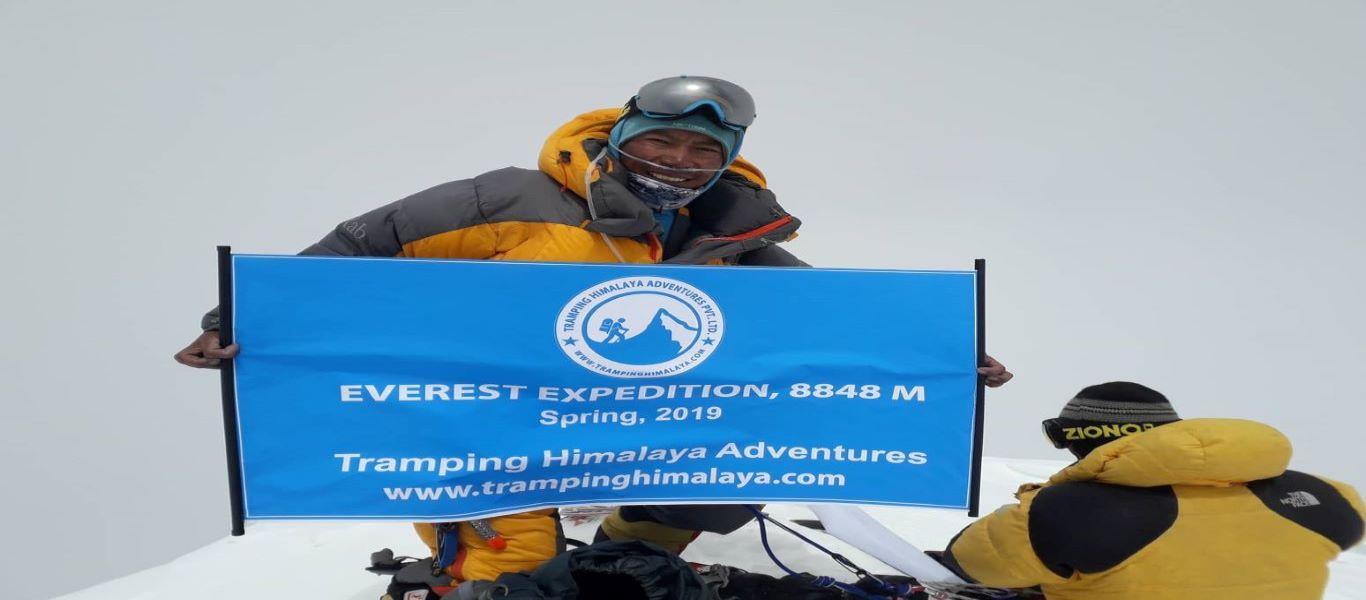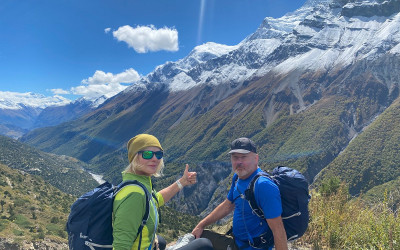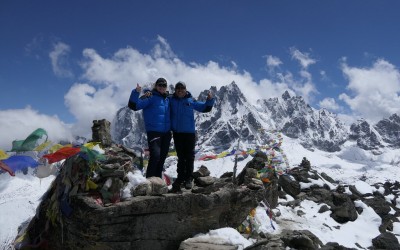Trip At Glance
-
Group Size2-15 Persons
-
Max Elevation8848 Meters
-
GradeFull Fledge Mountaineering Climbing Classification
-
DestinationNepal
-
TransportationPrivate Car/Bus and Flight
-
AccommodationHotel/Guest house/Camping
-
CostContact Us
-
Trip Length50 days
-
Best MonthMarch to May
-
WIFIAvailable
-
RegionExpedition
-
Trip ModeTrekking & Climbing
-
MealB/L/D
-
Trekking StyleTea House & Camping
overview
Trip Overview
‘a daring feat on world highest peaks on the roof top of the world’
Mt. Everest Expedition, a dream of countless mountaineers to step on top roof of the world following same earlier route of famous Tenzing and Hillary to reach Mt. Everest via South Col with spectacular panorama of mountains of both Nepal and Tibet sides and as far towards Mt. Kanchenjunga with Mt. Makalu. Mt. Everest South Col Expeditions, where adventurous and scenic walks leads you at the foot of Mt. Everest that towers high above 8,848 m and 29,028 ft high the mountain top regarded as Third Pole with various names to honor Sagarmatha in Nepalese and Chomlungma in Sherpa of Tibetan origin, where both names means ‘Great Mother. Mt. Everest straddles the border between Nepal south and Tibet-China side known as North Col of Mt. Everest where most of the climbing is done through Nepal side on the earlier classic route to the top of this black rock pyramid as seen from Khumbu and Nepal.
Tramping Himalaya Mt. Everest South Col Expeditions leads you to successful climb to the summit backed and supported by our native veteran and professional mountaineers who have lead several climbing expeditions over the past years with great success and fame. We are delighted and glad to announce that our Mt. Everest South Col Expeditions is quite different to others with ample time to reach the summit with enough time to acclimatize as well practice on ice and rock climbing before the final ascent. Starting from the capital Kathmandu where every logistic and manpower support will be fully organized including all paper works related to the expeditions with packing and rechecking gears before beginning our marvelous adventure on Mt. Everest South Col Expeditions. Taking a short flight to reach at Khumbu areas of Everest in Lukla and then walking to reach the famed Namche Bazaar after a climb with scenic views all along the trek, at Namche with time for rest and re-checking our staff members and gears and then heading towards Everest Camp with couple of overnights stops on designated villages in the comfort of nice cozy lodges. After a week of rest and trekking reaching at Everest Base Camp, where camping will be established for the great ascent, here with time of 30 days to re-group climbers and sorting gears and then ferrying loads to respective camps on route Mt. Everest summit. With challenging crossing over massive Khumbu Ice Falls to reach the last camp at South Col at above 8,000 m which links with the route to Lhotse also, from South Col heading higher taking the route of Hillary steps to reach the summit top of Mt. Everest where all climbers feels in high spirits being on top of the world. After a great victory and triumph descend back safely to base camp and then on the road to Lukla for the flight back to Kathmandu with mesmerizing and overwhelming experience and adventure on Mt. Everest South Col Expeditions.
Trip at a Glance
Trip Mode: Hotel – Lodge (Tea-House) with camping from base camp onward.
Trekking Grade: Moderate to Adventurous
Climbing Grade: Full Fledge Mountaineering Climbing Classification.
Trekking Region: Nepal Far Mid East Himalaya around Khumbu region
People & Culture: Sherpa tribes of Buddhism religion with interesting old traditions and colorful cultures.
Expeditions Durations: 43 Nights & 44 Days (Lukla to Lukla).
Total Expeditions: 50 Nights & 51 Days (Kathmandu to Kathmandu)
Seasons: March to early June and September to November.
HIGHLIGHTS
Highlights of Mt. Everest Expedition
- Scenic flights to and from Lukla with awesome panorama of mountains with view of Everest
- Trekking into world heritage Sagarmatha National park enriched with lovely alpine forest
- Explore Sherpa traditional farm villages and monasteries of immense Buddhist cultures
- Enchanting pristine forest filled with tall rhododendron-magnolia-pines-oaks and fir trees
- Adventure on top world highest Mt. Everest with sweeping panorama of Khumbu and Rongbuk areas
- A daring mountaineering adventure following the footsteps of Tenzing and Hillary on top Mt. Everest”
ITINERARY
Detailed Itinerary
Cost Included
- Airport Pick up & Drop with private transport
- Hotel in Kathmandu 5 Nights 3-star standard with B/B Twin Sharing Basis
- Food accommodation Guide during the trek
- Tea house & Camping for Climbing trip
- Welcome & farewell dinners As per the itinerary all ground transportation is private,
- Domestic flights (Manthali-lukla-Manthali )
- Porter service (2 trekkers: 1 porter)
- Tramping Himalaya Adventures Duffel bag & T-shirt
- All the necessary paperwork, Trekking Permits, Gaupalika Entrance fees, and Tims
- High-quality tents and kitchen utensils for camping
- EVEREST EXPEDITION PERMIT ( ROYALTY: USD 11,000 FOR MEMBER
- 6 Oxygen ( 4 ltr ) Bottles for climbing members and 3 for Climbing Sherpa
- Mask & regulators 1 set for climbing member and Sherpa
- Gamow bag EBC for emergency rescue purposes
- All camping equipment in Advance Base Camp and other Camps
- 1:1 experienced private climbing sherpa guide for climbing support
- Government Liason Officer for the Everest Expedition
- Foods during the expedition period cooked by our experienced coom EBC+ Camp 2
- Required high-altitude food for climbing members and Sherpa for C-1, C-2, C-3 & C-4
- Insurance, wages, meals, and allowances for climbing sherpa and Base Camp Staff
- First Aid medical kits for the Group and Staffs.
- Icefall and rope fixing charges, tents, and high camps EBC C-1, C-2, C-3, and C-4
- Walkie-talkies and a satellite phone for communication ( USes Chare USD 5 Per Minute )
- Office service charges and Government taxes Levied in Nepal
Cost Excluded
- Nepalese visa fee ( Bring the right cash in USD and 2 passport-size photographs)
- 15 Days USD 30, 30 Days USD 50, 90 Days USD 125,
- Airfare International and domestic flights other than specified
- Lunch and dinner during your stay in Kathmandu Except for farewell dinner in Kathmandu
- Clothing, Packing items, Personal medical Kit, Personal trekking/climing gears
- Items of personal nature like phone calls and like laundry and internet uses,
- Any extra service or products or offers or activities not mentioned in the Itinerary
- Any additional staff (s) especially required by the climbing member
- Rescue, repatriation, medicines, medical tests and hospitalization expenses
- Medical travel insurance and emergency rescue evacuation if required
- Any extra expenses arising out of various/unforeseen situations like natural calamities, landslides, political disturbances, Strikes, Changes in Government regulations, etc,
- Nepal custom duty fees for import or expedition good if required
- Summit bonus to the personnel claiming Sherpa ( Beginning from a minimum of USD 1800 per Summit per Sherpa)
- Tips for Base Camp Staffs per climbing member from a minimum of USD 300 in total for all the staff
- Any other item not mentioned in the service package exclude section,
















